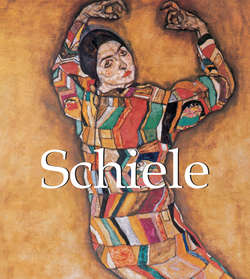Читать книгу Schiele - Ashley Bassie - Страница 5
На сайте Литреса книга снята с продажи.
Klimt’s Paternity
ОглавлениеVienna was the capital city of the Habsburg monarchy, a state of multiple ethnicities consisting of twelve nations with a population of approximately thirty million. Emperor Franz Josef maintained strict Spanish court etiquette. Yet, on the government’s fortieth anniversary, he began a large-scale conversion of the city, with its approximately 850 public and private monumental structures and buildings. During this time, the influx of the rural population selling itself to the big city was increasing.
Black-Haired Nude Girl, Standing
1910
Watercolour and pencil with white highlights
54.3 × 30.7 cm
Albertina, Vienna
The increasing industrialisation resulted in the emergence of a proletariat in the suburbs, while the newly rich bourgeoisie settled in the exclusive Ring Street. In the writers’ cafés, Leo Trotsky, Lenin and, later, Hitler consulted periodicals on display and brooded over the beginning century.
Just how musty the artistic climate in Vienna was is evidenced by the scandal which erupted in 1893 over Engelhard’s picture Young Girl under a Cherry Tree.
Albertina, Vienna
Seated Nude Girl
1910
Gouache and black pencil with white highlights
44.8 × 29.9 cm
The painting was repudiated on the grounds of “respect for the genteel female audience, which one does not wish to embarrass so painfully vis-à-vis such an open-hearted naturalistic study”. What hypocrisy, when official exhibitions of nude studies, the obligation of every artist, had long been an institution.
In 1897 Klimt, together with his Viennese fellow artists, founded the Vienna Secession, a splinter group separate from the officially accepted conduct for artists with the motto: “To the times its art, to the art its freedom.”
The Scornful Woman (Gertrude Schiele)
1910
Gouache, watercolour and charcoal with white highlights
45 × 31.4 cm
Private collection
In 1898, the first exhibition took place in a building belonging to the horticultural society. It was distinguished from the usual exhibitions which usually included several thousand works by offering an elite selection of 100 to 200 works of art. The proceeds, generated by the attendance of approximately 100,000 visitors, financed a new gallery designed by the architect Olbrich. Exhibitions by Rodin, Kollwitz, Hodler, Manet, Monet, Renoir, Cézanne and Van Gogh opened the doors to the most up-to-date international art world.
The Dead Mother I
1910
Pencil and oil on wood, 32.4 × 25.8 cm
Leopold Museum, Vienna
Visual artists worked beside renowned writers and musicians such as Rilke, Schnitzler, Alternberg, Schönberg and Alban Berg for the periodical Ver Sacrum. Here, they developed the idea of the ‘complete’ work of art which encompassed all artistic areas. Simultaneously, the Secession required the abolition of the distinction between higher and lower art, art for the rich and art for the poor and declared art common property. Yet, this demand of the art nouveau generation remained a privilege of the upper class striving for the ideal that “art is a lifestyle”, which encompassed architectural style, interior design, clothing and jewellery.
Schiele Drawing a Nude Model in front of a Mirror
1910
Pencil, 55.2 × 35.3 cm
Albertina, Vienna
Schiele’s artistic roots were in the “Jugendstil” of the Viennese Secession movement. Like a whole generation, he came under the influence of Vienna’s most charismatic and celebrated artist, Gustav Klimt (1862–1918). In Vienna’s creative effervescence, the two major figures of Austrian expressionism, Schiele and Kokoschka, would fully expand their talents under the tutelage of Klimt.
Конец ознакомительного фрагмента. Купить книгу
